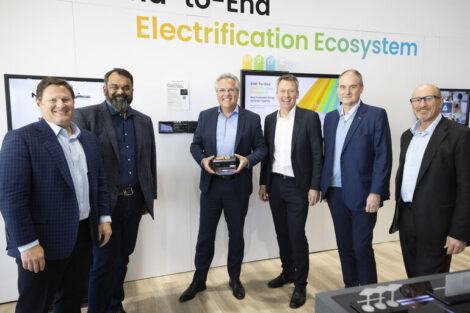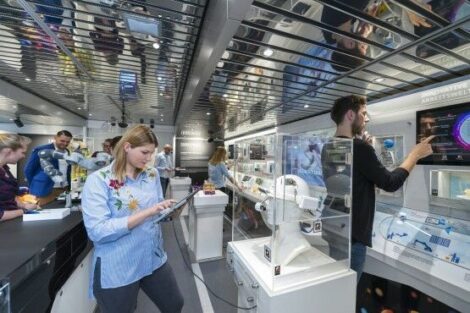EPP Europe: We‘re pleased to hear that ASMPT aims to be carbon neutral by 2035…
Guenter Lauber: Wait a minute, let me stop you there and clarify that our goal is Net Zero 2035 for Scope 1 and Scope 2. This means that we want to become carbon neutral in terms of our direct emissions – from heating systems or company vehicles (Scope 1), for example, and indirect emissions from our electricity suppliers (Scope 2). As with all statements about sustainability, it is very important to be precise and transparent regarding the framework you are referring to – as we are in our ESG Reports. Anyone who makes overly general statements about sustainability will rightly have to put up with the accusation of greenwashing.
Can you provide a bit more insight into ASMPT’s sustainability goals?
ASMPT’s ESG strategy is based on UN SDGs 3, 4, 5, 7, 8, 9, 11, 12, and 13. But let me be a little more specific. Although sustainability and ESG are highly complex topics that affect all processes, departments, segments and regions of ASMPT, we have already made good progress in this field. In the area of governance, we have carried out our risk assessment, established our processes, and are actively meeting the requirements placed on us by governments and markets. We have published an ESG Report, in which we disclose ESG targets and results, since 2017, for instance.
What is your new net-zero strategy?
To achieve a CO2-free footprint as quickly as possible, we decided some time ago to switch to solar and wind power and to save energy in all areas of the company. What is new is that we have defined a roadmap and published our commitment to a concrete goal. In so doing, we are challenging ourselves and, at the same time, wanting to live up to the responsibility we have through our prominent position in the industry – an industry which Dr. Isabel Al-Dahir, technology analyst at IDTechEx, says accounts for up to 4 percent of global greenhouse gas emissions. Regardless of how high the value really is, it is clear we must not stand still.
You already mentioned that companies must focus on the sustainability goals that are most relevant to them, but that this is also determined by economic factors. How does this apply at ASMPT?
Traditionally, profitability assessments have been dominated by the interests of shareholders, often at the expense of other interest groups. Sustainability initiatives were thus often rejected by the argument “no customer is going to pay us for that”. But this has changed. Not least because products that do not meet customers‘ sustainability requirements will not be sold in the future. Sustainable companies are redefining the business ecosystem by designing models that create value for all stakeholders, including employees, shareholders, supply chains, society, and the planet. In terms of the environment, we have prioritized topics based on the materiality matrix. While climate change, greenhouse gas emissions, energy-efficient products and energy management are of great importance to our stakeholders, they also have a major impact on ASMPT’s business. The economic benefits of some measures are obvious: energy-efficient products are more attractive, and energy-saving measures, including generating your own energy, pay for themselves after a certain period of time. The positive impact on the recruitment of workers, especially the younger generation, is equally obvious. What is often overlooked, however, is that, according to recent reports, investors are increasingly using companies’ non-financial disclosures to make investment decisions. In one meta-study, 90 percent of 200 studies analyzed concluded that good ESG standards reduce the cost of capital; 88 percent show that good ESG practices lead to better operational performance, and 80 percent show that share price performance is positively correlated with good sustainability practices. The development of sustainable alternatives in products and operational processes is a driver of innovation.
How exactly does ASMPT
approach ESG, SDG and net-zero?
Our vision proclaims: “Shaping a bright & sustainable future for customers, employees, investors, partners and society”. All employees must be able to develop awareness of ESG and sustainability issues in general, and of ASMPT’s focused activities in particular. To achieve this, we have established a central and cross-functional Environmental, Social & Governance (ESG) Team. This global team focuses on achieving our ambitious net-zero targets across all ASMPT segments. It has also defined and communicated our net-zero targets for Scopes 1 and 2. To this end, we have identified the most effective emission-reducing levers and measures, prioritized, and selected suitable and proven practices for CO2 avoidance, and provided the necessary financial resources. With a focus on our targets, these measures are reviewed and reported on every two months at each ASMPT site.
What kinds of measures would those be?
Measures to reduce emissions include, for example, reducing the energy demand at each of our sites by investing in new systems. Others include generating electricity from renewable sources in-house, and the electrification of vehicles. All this is supported by OpEx measures, such as the procurement of electricity from renewable energy sources and the purchase of green electricity and CO2 compensation certificates. When discussing such measures, we must consider each location separately. We cannot generate our own energy at will at all our locations, and not all our sites have providers who supply electricity from renewable sources.
Can you give us a few examples of measures that have already been taken?
Let me mention a few. Since 2019, we have achieved some initial success with our ESG measures and reduced CO2 emissions by 30 percent at our sites in Munich, Weymouth and Singapore. A few months ago we completed the installation of more than 1,200 solar panels at our global headquarters in Singapore. Solar panels are also already in use in Weymouth, UK, and in Huizhou, China.
You mentioned that your Net Zero 2035 program applies to Scope 1 and Scope 2 of the Greenhouse Gas Protocol. What are your plans for Scope 3?
Scope 3 refers to indirect emissions resulting from activities along the supply chain. This includes pollutant emissions which result from purchased goods and services, the use of products by customers, and the transportation of goods to customers – all highly complex issues. ASMPT has started to define the basics of Scope 3 emissions, such as those from the use of our products, whose energy efficiency is an issue that has long been close to our hearts. We are in the process of measuring Scope 3 emissions so that we will be able to set Scope 3 targets and reduction pathways. But reducing Scope 3 emissions is not possible without cooperation across the industry. This is one of the reasons we launched the Semiconductor Climate Consortium (SCC) in
November 2022 as a Leadership Level founding member. The SCC is the first global consortium of semiconductor companies that focuses on reducing greenhouse gas emissions. We hope that the consortium will empower each member to make an impact that goes far beyond its individual capabilities to combat climate change.
Finally, what advice would you give to colleagues in the industry who are still in the very early stages of ESG?
In a few words: do not be deterred by tasks that may seem complex at first. Educate yourself and identify possible starting points for your company. Just get started and take it one step at a time. Even if some measures seem like a drop in the ocean, we know many drops add up to the ocean.
Mr. Lauber, we thank you for this interview.
Productronica, Booth A3.377
Road to sustainability
Honesty is best policy
“Anyone who makes overly general statements about sustainability will rightly have to put up with the accusation of greenwashing.”
Challenge yourself
“We are challenging ourselves and, at the same time, trying to live up to our responsibility as a prominent player in the industry – an industry which [reports suggest] accounts for up to four percent of global greenhouse gas emissions.”
Invest in the future
“Sustainable companies are redefining the business ecosystem by designing models that create value for all stakeholders, including employees, shareholders, supply chains, society, and the planet.”
ASMPT measures for Net Zero 2035
· Ongoing: energy-saving measures are being implemented in various areas, for example in
facility management.
· By 2026: solar panels at five key sites in Southeast Asia and Europe.
Reduction of the energy consumption of our Chinese locations.
· By 2030: all Southeast Asian and European production locations are scheduled to use energy
from renewable sources exclusively.
·By 2035: all ASMPT production locations worldwide are scheduled to use 100 percent
renewable energies.













